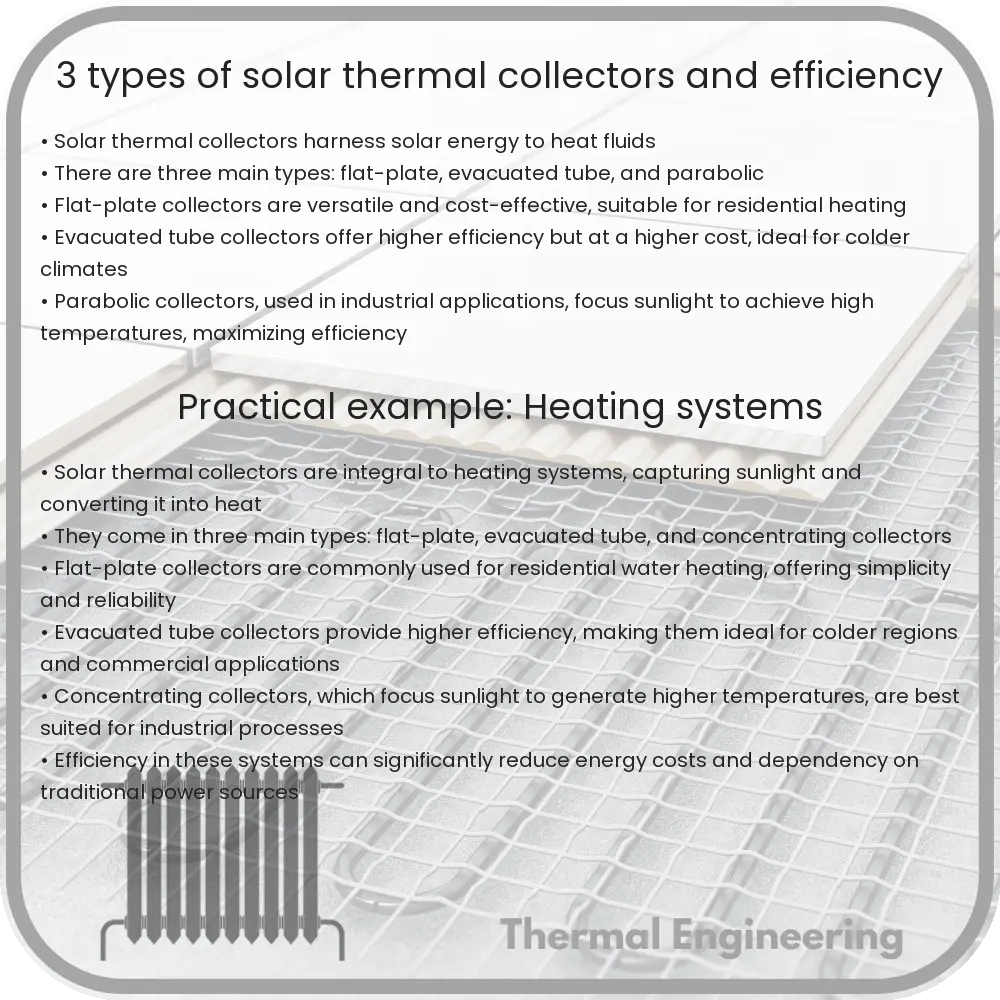Learn about solar thermal collectors, devices that transform sunlight into heat for water and space heating, and industrial uses.

Understanding Solar Thermal Collectors
Solar thermal collectors are devices designed to collect and convert sunlight into thermal energy (heat), which can be used for heating water, space heating, or even powering industrial processes. These systems are a sustainable alternative to conventional water heating methods, utilizing the abundant energy provided by the sun. There are several types of solar thermal collectors, each suited to different climate conditions and applications. The efficiency of these collectors is a key aspect in their performance, significantly impacting their adoption and effectiveness in real-world applications.
Types of Solar Thermal Collectors
There are primarily three types of solar thermal collectors, categorized based on their design and operational temperature:
- Flat Plate Collectors
Flat plate collectors are the most common type of solar thermal collector for domestic use and can be identified by their flat, rectangular shape. They consist of a dark flat-plate absorber, a transparent cover (often glass), a heat-insulating backing, and a fluid for heat transport. The absorber captures the solar radiation and transfers it to the fluid running through the collector, which can then be used directly or stored for later use. Flat plate collectors are typically used for residential hot water systems.
- Evacuated Tube Collectors
Evacuated tube collectors feature several cylindrical tubes, which, as the name suggests, are evacuated (air is removed to create a vacuum). The vacuum serves as an excellent insulator and greatly reduces convection and conduction losses from the collector surface, making them more efficient than flat plate collectors, especially in colder climates. These collectors are composed of rows of parallel transparent tubes each containing an absorber tube. This design allows them to absorb heat from the sun efficiently while minimizing heat loss.
- Parabolic Trough Collectors
Parabolic troughs are large, curved reflectors that concentrate sunlight onto a tube (receiver) positioned at the focus of the parabola. The concentrated sunlight heats the fluid inside the receiver to high temperatures, which can then be used to produce steam for electricity generation or industrial processes. Because of their high temperature capabilities, parabolic troughs are often used in solar power plants or in industrial settings rather than for domestic purposes.
Efficiency of Solar Thermal Collectors
The efficiency of solar thermal collectors is generally defined as the ratio of the energy output from the collector to the solar energy input. The efficiency depends on various factors including the type of collector, the materials used, the temperature difference between the collector surface and the ambient air, and the amount of solar irradiance. Efficiency can be expressed with the formula:
Efficiency (%) = (Energy Output / Solar Irradiance) * 100
For example:
- Flat plate collectors typically have efficiencies ranging from 60-75%.
- Evacuated tube collectors offer higher efficiencies, often between 70-80%, due to their insulating vacuum.
- Parabolic trough systems can achieve efficiencies around 60-65%, but they can operate at much higher temperatures.
Overall, the efficiency of solar thermal collectors is an important measure as it directly influences their heat output and feasibility for various applications. Choosing the right type of collector and optimizing system design for specific local conditions can substantially improve performance and energy savings.
Conclusion
Solar thermal collectors provide a viable and efficient way to harness solar energy for thermal purposes. The choice between flat plate collectors, evacuated tube collectors, and parabolic troughs depends on the specific needs and geographical conditions of the user. With ongoing advances in technology and materials science, the efficiency and applicability of solar thermal collectors continue to improve, promising an increasingly sustainable future.